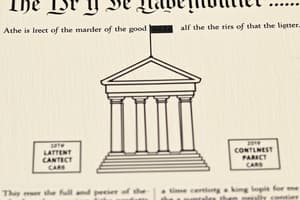Podcast
Questions and Answers
If both the President and Vice President are unable to serve, who assumes the office of President?
If both the President and Vice President are unable to serve, who assumes the office of President?
- Secretary of State
- President Pro Tempore of the Senate
- Speaker of the House (correct)
- Chief Justice of the Supreme Court
Which of the following scenarios best exemplifies the role outlined for the judicial branch?
Which of the following scenarios best exemplifies the role outlined for the judicial branch?
- The President negotiates a trade agreement with a foreign nation.
- Congress passes a new environmental law after extensive debate.
- The Supreme Court hears a case regarding the interpretation of free speech. (correct)
- A state governor proposes changes to education funding.
A proposed law requires a simple majority in both the House of Representatives and the Senate to pass, but the President vetoes it. What action can Congress take to override the veto and enact the law?
A proposed law requires a simple majority in both the House of Representatives and the Senate to pass, but the President vetoes it. What action can Congress take to override the veto and enact the law?
- A two-thirds vote in the Senate only
- Referendum vote by the people
- A simple majority vote in a joint session of Congress
- A two-thirds vote in both the House and the Senate (correct)
Which of the following scenarios would be a violation of the First Amendment?
Which of the following scenarios would be a violation of the First Amendment?
How does the 22nd Amendment impact the executive branch?
How does the 22nd Amendment impact the executive branch?
A state law conflicts with a federal law. Which principle determines which law prevails, and why?
A state law conflicts with a federal law. Which principle determines which law prevails, and why?
What constitutional principle is best demonstrated by the division of power between the legislative, executive, and judicial branches?
What constitutional principle is best demonstrated by the division of power between the legislative, executive, and judicial branches?
Which of the following actions can be taken to directly change the language of the Constitution?
Which of the following actions can be taken to directly change the language of the Constitution?
Flashcards
Presidential Succession
Presidential Succession
If both President and Vice President can no longer serve, the Speaker of the House becomes President.
Sandra Day O'Connor
Sandra Day O'Connor
The first woman to serve on the Supreme Court.
Amendment
Amendment
A change or addition to the U.S. Constitution.
Supreme Law
Supreme Law
Signup and view all the flashcards
First Amendment
First Amendment
Signup and view all the flashcards
Representative Democracy
Representative Democracy
Signup and view all the flashcards
Declaration of Independence (rights)
Declaration of Independence (rights)
Signup and view all the flashcards
Minimum Age for President
Minimum Age for President
Signup and view all the flashcards
Study Notes
- If both the President and Vice President are unable to serve, the Speaker of the House becomes President.
- Sandra Day O'Connor was the first woman to serve on the Supreme Court.
- A U.S. Senator serves a term of 6 years.
- There have been 6 women who have served on the Supreme Court.
- A U.S. Representative serves a term of 2 years.
- The Executive Branch of the government is led by the President.
- The Supreme Court is the highest court in the U.S.
- Federal laws are made by Congress.
- An amendment is a change to the Constitution.
- The Constitution is the supreme law of the land.
- Powers of the federal government include regulating commerce, taxing, national defense, foreign policy, coining money, establishing post offices, and enforcing laws.
- There are 27 amendments to the Constitution.
- There are 100 U.S. Senators, with 2 from each state.
- The First Amendment protects freedom of speech, religion, press, assembly, and to petition the government.
- There are 435 U.S. Representatives.
- A representative democracy is where the people elect representatives.
- Two rights listed in the Declaration of Independence are life and liberty.
- The minimum age required to be President is 35.
- A President's term in office is 4 years.
- The living current and former presidents are Joe Biden, Donald Trump, George W. Bush, Bill Clinton, Barack Obama, and Jimmy Carter.
- The introduction to the Constitution is "We the People."
- A Supreme Court justice serves for life or until retirement.
- A constituent is a member of a voting district.
- The 26th Amendment states that 18-year-olds can vote
- Presidents nominate judges.
- The 19th Amendment grants women the right to vote.
- The Judicial branch interprets laws.
- The 27th Amendment prevents Congress from giving themselves immediate pay raises.
- There are 9 justices on the Supreme Court.
- The 13th Amendment abolishes slavery.
- Powers of the states include creating local governments and schools.
- The 22nd Amendment limits the President to serving only 2 terms.
- You have to be 18 years old to vote for President.
- The 25th Amendment states that the Vice President becomes President if something happens to the President.
- The two parts of the U.S. Congress are the Senate and the House of Representatives.
- The 16th Amendment allows the U.S. to collect income taxes.
- The three branches of government are the Legislative, Executive, and Judicial.
- Concurrent powers are held by both state and national governments.
- The President signs a bill to become law.
- Reserved powers are held by state governments.
- Male U.S. citizens must register for the Selective Service within 30 days of their 18th birthday.
- Enumerated powers are held by the national government.
- Selective Service registration is required at age 18.
Studying That Suits You
Use AI to generate personalized quizzes and flashcards to suit your learning preferences.




